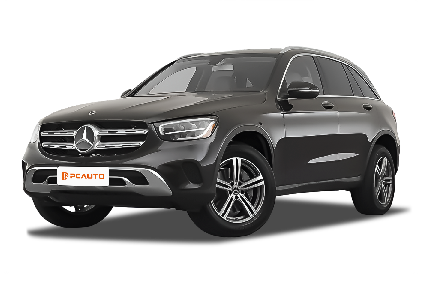Q
Is the Mercedes GLC a 7-seater layout?
Not all Mercedes GLC models are designed as seven-seaters. The standard Mercedes GLC typically features five seats, as seen in many of the models listed. However, there are extended versions of the GLC, such as the GLC 300 L 4MATIC 7-Seater, which offers a third row of seats for accommodating up to seven passengers. These seven-seat variants generally come with a longer wheelbase, providing additional space in the rear for the extra seating.
Such configurations are ideal for larger families or those who frequently need to transport more passengers. Availability of the seven-seat options may vary, so it’s best to check with local dealers or visit the Mercedes-Benz official website for the most accurate information regarding the GLC series' seven-seat offerings.
Special Disclaimer: This content is published by users and does not represent the views or position of PCauto.
Related Q&A
Q
Does GLC 2023 have a sunroof?
The 2023 Mercedes-Benz GLC in the Malaysian market is indeed equipped with a Panoramic Sunroof. This feature comes as standard in the high-end versions of the GLC, providing excellent lighting and ventilation inside the vehicle. At the same time, it enhances the overall luxury feel and the riding experience of the car. The panoramic sunroof is especially popular in tropical-climate regions like Malaysia, as it allows passengers to enjoy a wider view while avoiding direct sunlight. As a luxury SUV, the sunroof design of the Mercedes-Benz GLC not only focuses on aesthetics but also uses heat-insulating and UV-resistant glass to ensure in-car comfort.
In addition, the 2023 GLC is also equipped with the advanced MBUX infotainment system and a variety of driving assistance functions, further improving the convenience of driving and riding. If you have any questions about the operation or maintenance of the GLC's sunroof, it is recommended to refer to the owner's manual or consult an authorized dealer to ensure the proper use and maintenance of this feature.
Q
What is the top variant of Mercedes GLC 2023?
In the Malaysian market in 2023, the top-spec model of the Mercedes-Benz GLC is the Mercedes-Benz GLC 300 4MATIC AMG Line. This model is equipped with a 2.0-liter turbocharged four - cylinder engine, with a maximum output power of 258 horsepower and a peak torque of 400 Nm. It is paired with a 9-speed automatic transmission and the 4MATIC all - wheel drive system, offering excellent power performance and handling experience. The AMG Line package includes a sporty exterior design, exclusive wheels, and interior trims, further enhancing the sense of luxury and sporty atmosphere.
In addition, the GLC 300 4MATIC AMG Line is also equipped with the advanced MBUX infotainment system, a panoramic sunroof, an intelligent driving assistance system, and a variety of luxury features, providing Malaysian consumers with a high-end driving and riding experience. It's worth mentioning that the GLC series has always been well-received in the Malaysian market. It combines luxury, technology, and practicality, making it suitable for family use or business needs. Meanwhile, Mercedes-Benz's after-sales service network in Malaysia is also quite comprehensive, providing reliable support for car owners.
Q
Does the Mercedes GLC 2023 have air suspension?
Among the versions of the 2023 Mercedes-Benz GLC available in the Malaysian market, the standard configuration does not include an air suspension system. However, some high-end models or optional packages may offer the AIRMATIC air suspension as an optional item. You need to confirm the specific details according to the configuration list provided by local dealers. The air suspension adjusts the air pressure to change the vehicle's body height and stiffness. It can improve comfort (such as filtering out bumps) or enhance sportiness (lowering the body at high speeds), which is suitable for the diverse road conditions in Malaysia. But it should be noted that its maintenance cost is higher than that of traditional spring suspensions. If users are pursuing a higher-quality driving experience, they can consult authorized dealers for details about the optional item. At the same time, compare the suspension technology features of luxury SUVs of the same class from German or Japanese brands, such as BMW's electronic suspension or Lexus's Adaptive Variable Suspension, and make a choice based on their budget and needs. The hot and rainy climate in Malaysia places high requirements on the durability of the suspension system. Regularly checking the seals and air pressure pipelines is the key to maintaining the performance of the air suspension.
Q
How much is the GLC 300 in 2023?
In the Malaysian market, the official starting price for the 2023 Mercedes-Benz GLC 300 is around RM390,000 to RM430,000, depending on the model year, specific configuration options, and dealer discounts. It is highly recommended to consult authorized dealers directly for the most accurate and up-to-date quotations. As a representative of Mercedes-Benz's mid-size luxury SUVs, the GLC 300 is equipped with a 2.0-liter turbocharged engine featuring a 48V mild-hybrid system (MHEV), delivering 258 hp. It comes standard with the 4MATIC all-wheel-drive system, balancing power and handling stability. This model is quite popular in Malaysia. Its advantages include exquisite interior craftsmanship, the advanced MBUX multimedia system, and a comprehensive suite of active safety features such as adaptive cruise control and lane-keeping assist. It is worth noting that competitors in the same class, like the BMW X3 and Audi Q5, are also strong choices. However, the GLC 300 is often perceived to hold an edge in brand prestige and the creation of a luxury ambiance. When purchasing in Malaysia, prospective buyers should factor in additional costs such as road tax and insurance. It is also advisable to inquire about promotional activities that some dealers may offer, such as complimentary maintenance packages.
Q
How much is a used Mercedes GLC 2023?
In Malaysia, the prices of used 2023 Mercedes-Benz GLCs vary depending on factors such as the vehicle's condition, mileage, configuration, and warranty status. Currently, the market prices range from approximately RM250,000 to RM350,000, specifically depending on whether the vehicle is equipped with options like the AMG package, high-end audio system, or driving assistance systems. When purchasing a used GLC, it is advisable to check the vehicle's maintenance records and whether it is still within the original factory warranty to ensure its reliability.
As a luxury mid-size SUV, the Mercedes-Benz GLC is renowned for its exquisite interior, excellent driving experience, and advanced safety technology. The 2023 model is even equipped with an updated MBUX infotainment system, enhancing the user experience. Moreover, there has always been a high demand for Mercedes-Benz models in the Malaysian used-car market, especially popular models like the GLC, which have relatively good resale values. However, it is recommended to conduct transactions through officially certified used-car channels or reputable dealers before buying a car to obtain more comprehensive after-sales support.
Q
What kind of engine is in the GLC 2023?
The 2023 Mercedes-Benz GLC offers both gasoline and diesel engine options in the Malaysian market. The gasoline version is equipped with a 2.0-liter four-cylinder turbocharged M254 engine, which comes with a 48V mild-hybrid system. It has a maximum output power of 258 horsepower and a peak torque of 400 Nm. This powertrain not only improves fuel economy but also optimizes the power response at low speeds.
The diesel version, on the other hand, uses a 2.0-liter four-cylinder turbocharged OM654 engine, with a maximum power of 194 horsepower and a peak torque of 440 Nm. It's suitable for consumers who focus on long-distance driving and fuel efficiency.
It's worth mentioning that the 48V mild-hybrid technology has become an important development direction for Mercedes in recent years. It can provide additional assistance when the vehicle starts and drives at low speeds, and also supports functions like coasting with the engine off, further reducing fuel consumption. For Malaysian consumers, this technology can not only meet their daily driving needs but also adapt to the relatively congested local traffic environment.
In addition, the entire 2023 GLC lineup is standard with a 9-speed automatic transmission (9G-TRONIC), which shifts smoothly and efficiently, providing a comfortable driving experience whether it's for city commuting or highway cruising.
Q
Is the 2023 GLC a hybrid?
In 2023, the Mercedes-Benz GLC (model X254) does offer a hybrid version in the Malaysian market. Specifically, it's the GLC 300e 4MATIC plug-in hybrid electric vehicle (PHEV). This model is equipped with a combination of a 2.0- liter turbocharged engine and an electric motor. The combined system output reaches 313 horsepower, and it has an all-electric range of about 100 kilometers (WLTP standard). It's suitable for short-distance commuting and allows users to enjoy the tax incentives provided by the Malaysian government for hybrid vehicles.
Apart from the hybrid version, the Malaysian market has also introduced the gasoline-powered GLC 200 and GLC 300 in parallel to meet the needs of different consumers. Hybrid technology is an important trend in the current automotive industry as it can effectively reduce fuel consumption and emissions. Mercedes-Benz's PHEV system combines power performance and environmental advantages. You can charge it using a household socket or a public charging pile, and it's highly practical given the gradually improving charging infrastructure in Malaysia.
If you're considering a hybrid vehicle, it's recommended to evaluate based on your daily driving mileage and charging convenience. Also, compare it with other luxury brand competitors such as the plug-in hybrid version of the BMW X3 or the Volvo XC60 Recharge. However, keep in mind that the actual experience may vary depending on driving habits and road conditions.
Q
What is the difference between GLC 2023 and 2024?
The main differences between the 2023 and 2024 Mercedes-Benz GLC models are concentrated on the optimization of technological configurations and the powertrain. The 2024 model comes standard with the updated MBUX infotainment system in the Malaysian market, which supports more natural voice control functions. At the same time, an upgraded version of the 48V mild-hybrid system is introduced to some models, improving fuel economy by about 5%. In addition, the headlight group uses more advanced digital lighting technology, providing a clearer night vision.
For Malaysian consumers, the 2024 model also optimizes the air-conditioning system for the tropical climate and adds a wireless Android Auto connection function and has a relatively more advantageous price.
It's worth noting that Mercedes-Benz usually adjusts the suspension tuning according to local road conditions in the Southeast Asian market, and both models continue this tradition. The 2024 model further enhances the chassis's adaptability to Malaysia's rainy weather.
When considering the resale value of used cars, in the Malaysian market, the price of the old model usually drops slightly after the new model is released. However, due to the high brand recognition, the Mercedes-Benz GLC series always performs better in terms of resale value than its peers.
Q
How often should a Mercedes GLC 2024 be serviced?
According to Mercedes-Benz's official maintenance recommendations, under normal operating conditions in Malaysia, the 2024 GLC should undergo regular maintenance every 10,000 kilometers or 12 months, whichever comes first. The hot and humid climate in Malaysia, along with the congested urban traffic, may accelerate the wear and tear of engine oil and filters. Therefore, it is recommended that car owners shorten the maintenance interval to every 8,000 - 10,000 kilometers. Special attention should be paid to checking the air - conditioning system, brake fluid, and battery status.
The turbocharged engine in this model has high requirements for engine oil quality. It is essential to use fully synthetic engine oil that meets the MB - Approval 229.51/229.52 standards. In addition to regular maintenance, it is advisable to check the wheel alignment and brake pad thickness every 20,000 kilometers. Before the rainy season, pay special attention to the sunroof drain pipes and anti - rust treatment of the chassis.
The Service Care package offered by authorized dealers in Malaysia usually includes 15 core inspection items, which comprehensively cover the inspection of the transmission system, electronic devices, and safety configurations. If you often drive long distances or in dusty environments, you may consider replacing the air filter earlier.
It should be noted that strictly following the maintenance manual not only helps maintain the vehicle's optimal performance but also extends the original factory warranty. For hybrid models, it is even more crucial to conduct special inspections of the high - voltage system on schedule.
Q
How long will a GLC 2024 last?
The service life of the 2024 Mercedes-Benz GLC depends on various factors, including daily maintenance, driving habits, as well as the road conditions and climate in Malaysia. If you regularly maintain the vehicle according to the manufacturer's recommendations, use original parts, and avoid aggressive driving, the GLC 2024 can usually travel over 200,000 kilometers, or even longer. The high - temperature and humid weather in Malaysia may have a certain impact on the vehicle's electronic components and rubber parts. It is recommended to pay special attention to the maintenance of the air - conditioning system and door seals.
The key to extending the vehicle's life also includes regularly replacing fluids such as engine oil and brake fluid, and promptly addressing minor issues to prevent them from worsening. Mercedes - Benz vehicles are generally known for their durability and high quality. The advanced technologies equipped in the GLC 2024, such as the 48V mild - hybrid system, also help reduce engine wear.
For users in Malaysia, it is very important to choose a regular Mercedes - Benz authorized service center for maintenance, as they are more familiar with the impact of the local environment on the vehicle and can provide professional maintenance advice. In addition, when the vehicle is parked for a long time, it is recommended to start it regularly to keep the battery and mechanical components in good condition. With proper use and maintenance, the GLC 2024 can fully meet the long - term usage needs of Malaysian car owners.
Latest Q&A
Q
What is the cheapest 2024 Range Rover?
In the Malaysian market, the most affordable model of the 2024 Range Rover lineup is the Range Rover Evoque. The starting price of its entry - level version is around RM400,000, and the actual price may vary depending on the configuration, optional accessories, and dealer promotions. As the entry - level SUV in the Range Rover family, the Evoque retains the brand's iconic luxury design language and off - road capabilities. It is also equipped with an efficient turbocharged engine and advanced technological features, such as the Pivi Pro infotainment system and the Terrain Response all - terrain feedback system, making it a great fit for both city driving in Malaysia and occasional outdoor adventures. If you have a limited budget but still want to experience the luxury of Range Rover, the Evoque is a good option. Meanwhile, the Range Rover Velar in the same series is positioned a bit higher, with a starting price of approximately RM500,000, offering more spacious interiors and a wider range of features. When purchasing in Malaysia, it's advisable to compare the promotional offers from different dealers and take into account the long - term maintenance costs, as luxury cars generally have higher upkeep expenses. However, Range Rover has a good reputation for reliability and after - sales service in the local market.
Q
Will the Range Rover Evoque change in 2024?
Based on the current information, the 2024 Range Rover Evoque is expected to undergo some updates, but there may not be significant changes to the overall design. The updates will mainly focus on the optimization of technological features and the powertrain. For example, it might upgrade the infotainment system or incorporate more efficient mild - hybrid technology to meet global emission standards. In the Malaysian market, this vehicle is likely to maintain its popular position as a luxury compact SUV and adapt to local road conditions and consumer preferences. For instance, it could offer seat materials suitable for the tropical climate or an enhanced air - conditioning system. The Range Rover Evoque has always been known for its stylish design and off - road capabilities. The 2024 model may further enhance these features while maintaining the brand's consistent high - quality. Malaysian consumers can look forward to an even better driving experience through detailed improvements while retaining the existing advantages. As for the specific changes, we still need to wait for the official announcement for confirmation.
Q
What is the Range Rover Evoque 2024?
The 2024 Range Rover Evoque is a luxury compact SUV under Land Rover. It continues the brand's iconic refined design and outstanding performance, and is specifically designed for urban driving and mild off - road needs. This vehicle has attracted a lot of attention in the Malaysian market. The 2024 model is expected to be equipped with a more efficient mild - hybrid or plug - in hybrid system, which will further improve fuel economy while maintaining Land Rover's consistent all - terrain capabilities. It comes with the Terrain Response all - terrain feedback system, making it suitable for Malaysia's diverse road conditions.
In terms of the interior, the new car is expected to use high - end leather and metal trims, and be equipped with the latest Pivi Pro infotainment system, which supports wireless Apple CarPlay and Android Auto to meet the needs of tech enthusiasts. The body design continues the Evoque's classic floating roof and hidden door handles, highlighting a sense of fashion.
For Malaysian consumers, the compact size of the Evoque is very suitable for city driving. At the same time, its luxury features and brand premium also meet the local preference for high - end SUVs. It's worth mentioning that Land Rover has a well - established dealer network and after - sales service in Malaysia, providing reliable support for car owners. As an entry - level Land Rover model, the Evoque also gives more consumers the opportunity to experience the brand's luxury and performance.
Q
How much is a 2024 Range Rover Evoque?
The pricing of the 2024 Range Rover Evoque in Malaysia varies depending on the configuration. It's estimated to start from around RM280,000 to RM350,000. The exact price depends on the selected model (such as the S, SE, or HSE versions), the powertrain (like the 2.0-liter turbocharged petrol or diesel engine), and additional features (such as premium interiors and driver assistance systems).
This vehicle continues the Land Rover family's exquisite design. It comes equipped with the latest Pivi Pro infotainment system and the Terrain Response System, making it suitable for both city driving and light off - road adventures. In the Malaysian market, the Evoque is well - received for its luxury and practicality. Local agents also offer a variety of financial packages and warranty services, making it convenient for consumers to make a choice.
It's important to note that before purchasing, it's advisable to confirm the latest prices and promotional activities with authorized dealers, as the prices may be affected by exchange rates, taxes, or configuration updates. Additionally, the maintenance cost of the Evoque is relatively high, but the service packages provided by Land Rover Malaysia can help owners reduce long - term maintenance expenses.
Q
How often should a Mercedes GLC 2024 be serviced?
According to Mercedes-Benz's official maintenance recommendations, under normal operating conditions in Malaysia, the 2024 GLC should undergo regular maintenance every 10,000 kilometers or 12 months, whichever comes first. The hot and humid climate in Malaysia, along with the congested urban traffic, may accelerate the wear and tear of engine oil and filters. Therefore, it is recommended that car owners shorten the maintenance interval to every 8,000 - 10,000 kilometers. Special attention should be paid to checking the air - conditioning system, brake fluid, and battery status.
The turbocharged engine in this model has high requirements for engine oil quality. It is essential to use fully synthetic engine oil that meets the MB - Approval 229.51/229.52 standards. In addition to regular maintenance, it is advisable to check the wheel alignment and brake pad thickness every 20,000 kilometers. Before the rainy season, pay special attention to the sunroof drain pipes and anti - rust treatment of the chassis.
The Service Care package offered by authorized dealers in Malaysia usually includes 15 core inspection items, which comprehensively cover the inspection of the transmission system, electronic devices, and safety configurations. If you often drive long distances or in dusty environments, you may consider replacing the air filter earlier.
It should be noted that strictly following the maintenance manual not only helps maintain the vehicle's optimal performance but also extends the original factory warranty. For hybrid models, it is even more crucial to conduct special inspections of the high - voltage system on schedule.
View MoreRelated News

Mercedes-Benz releases teaser image of electric GLC, featuring a retro illuminated grille
RobertAug 5, 2025

Mercedes-Benz invests in an autonomous driving technology company under Geely named Qianli
AshleySep 25, 2025

Benz launches its first car equipped with solid-state batteries, capable of traveling 1,205 kilometers on a full charge
WilliamSep 10, 2025

Mercedes-Benz electric vehicle design language will also undergo a major change to respond to BMW Neue Klasse.
JamesSep 9, 2025

Mercedes-Benz CLA Electric Opens for Pre-Orders with Over 700km Range
AshleyAug 14, 2025
View More

















Pros
Cons